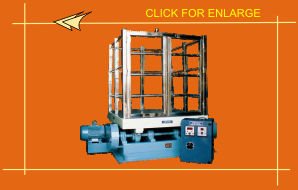Your Address : Globalchemmade--GOOD EARTH ENGINEERING INDUSTRIES
Name:GOOD EARTH ENGINEERING INDUSTRIES

Type:Others
Tel:91-22-28200559
Fax:91-22-26840346
Email:flextool@gmail.com
Address:India
Equipments detail
| Equipment: | PACKAGE & JOLT TESTING |  |
| Equipment Type: | Packaging Equipment -> Others | |
| Unit Type: | ||
| Technical Parameters: | ||
| Post Time: | 2010-06-04 | |
| Main Features: | ||
| Usage: | The packages (containers) intended for transportation of goods is required to fulfill the primary function of physical protection to the content within it. Normally the transportation is by road, rail, sea and air- in singular or in various combinations of these modes. Due to these the package is subjected to the various vibrations and jolts of varying intensities. It is very difficult to simulate these vibrations in totality, however, the machine is designed to simulate these conditions closely in the laboratory. The vibration test provides means to determine in advance, under standard laboratory conditions, how a filled package will fare in a given distribution system. This test is used to assess the performance of containers only, in terms of its strength and the protection that it provides to the content, when subjected to the vibrations during the transportation. | |
| Description: | The machine is rigidly fabricated from MS structure. The upper tabletop is suspended for vibration by bearing blocks. The fixed amplitude of 25mm is generated using cam assembly. The frequency of vibration can be varied using the panel box from 2 Hz to 10 Hz. The machine can generate the vibrations in three modes viz. 1. In phase vibrations, that is, both the cam assembly is in phase and the tabletop ends moves simultaneously. 2. 90 Deg out of phase, that is the cam assembly are 90 degrees out of phase with each other. One end of the table moves 90 degrees out of phase with respect to the other. 3. 180 Deg out of phase, that is, the cam assembly are totally out of phase. One end of the table moves 180 degree out of phase with respect to the other, so that the lowest point of the one side will coincide with the highest point of the other side of the table. | |